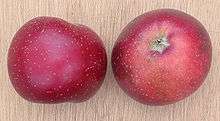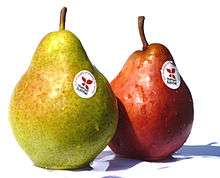Lenticel

A lenticel is a porous tissue consisting of cells with large intercellular spaces in the periderm of the secondarily thickened organs and the bark of woody stems and roots of dicotyledonous flowering plants.[2] It functions as a pore, providing a pathway for the direct exchange of gases between the internal tissues and atmosphere through the bark, which is otherwise impermeable to gases. The name lenticel, pronounced with an [s], derives from its lenticular (lens-like) shape.[3] The shape of lenticels is one of the characteristics used for tree identification.[4]
Formation
Lenticel formation usually begins beneath stomatal complexes during primary growth preceding the development of the first periderm. Lenticels are found as raised circular, oval, or elongated areas on stems and roots. As stems and roots mature lenticel development continues in the new periderm (for example, periderm that forms at the bottom of cracks in the bark). Lenticels are also found in pneumatophorous roots (respiratory roots).
Fruits

Lenticels are also present on many fruits, quite noticeably on many apples and pears. On European pears, they can serve as an indicator of when to pick the fruit, as light lenticels on the immature fruit darken and become brown and shallow from the formation of cork cells[5][6] Certain bacterial and fungal infections can penetrate fruits through their lenticels, with susceptibility sometimes increasing with its age.[7]
“Lenticel breakdown” is a global skin disorder of apples in which lenticels develop dark 1–8 mm diameter pits shortly after processing and packing.[8][9] It is most common on the ‘Gala’ (Malus × domestica) variety, particularly the ‘Royal Gala’, and also occurs in ‘Fuji’, ‘Granny Smith’, ‘Golden Delicious’, and ‘Delicious’ varieties.[8][9] It is more common in arid regions, and is thought to be related to relative humidity and temperature.[8][9] The effect can be mitigated by spraying the fruit with lipophilic coatings prior to harvest.[8]
Tubers
Lenticels are also present on potato tubers.[10]
Gallery
- Lenticels on Prunus serrula
- Lenticels on Wild Cherry or Gean.
- Alder bark (Alnus glutinosa) with characteristic lenticels and abnormal lenticels on callused areas.
 Lenticels on potatoes of the Monalisa variety.
Lenticels on potatoes of the Monalisa variety. Lenticels on Williams pear varieties.
Lenticels on Williams pear varieties.
Notes
- ↑ "Lenticel". The American Heritage Science Dictionary, Houghton Mifflin Company, via dictionary.com. Retrieved on 2007-10-11
- ↑ Gibson, Arthur C. "Bark Features in General Botany".
- ↑ Esau, K. (1953), Plant Anatomy, John Wiley & Sons Inc. New York, Chapman & Hall Ltd. London
- ↑ Michael G. Andreu; Erin M. Givens; Melissa H. Friedman. "How to Identify a Tree". University of Florida IFAS extension.
- ↑ Krewer, Gerard; Bertrand, Paul. "Home garden pears". CAES Publications. University of Georgia College of Agricultural and Environmental Sciences. Retrieved 18 January 2014.
- ↑ Pyzner, John (19 April 2005). "Pick pears before completely ripe, advises LSU AgCenter horticulturist". Louisiana State University Agricultural Center website. Archived from the original on 15 January 2014.
- ↑ Irtwange, S. V. (February, 2006.) "Application of modified atmosphere packaging and related technology in postharvest handling of fresh fruits and vegetables". Agricultural Engineering International: the CIGR Ejournal. Invited Overview No. 4. Vol. VIII, page 8. Retrieved on 2007-10-11.
- 1 2 3 4 Curry, Eric A.; Torres, Carolina; Neubauer, Luis (2008). "Preharvest lipophilic coatings reduce lenticel breakdown disorder in 'Gala' apples.". HortTechnology. 18 (4): 690–696.
- 1 2 3 Turketti, S.S.; Curry, E.; Lötze, E. (2012). "Role of lenticel morphology, frequency and density on incidence of lenticel breakdown in 'Gala' apples". Scientia Horticulturae. 138: 90–95. doi:10.1016/j.scienta.2012.02.010. ISSN 0304-4238.
- ↑ Adams, M. J. (1975). "Potato tuber lenticels: Development and structure". Annals of Applied Biology. 79 (3): 265. doi:10.1111/j.1744-7348.1975.tb01582.x.
References
- Raven, Peter H.; Ray F. Evert; Susan E. Eichorn (2005). Biology of Plants 7th Ed. W.H. Freeman and Company Publishers. pp. 586–587. ISBN 0-7167-1007-2.